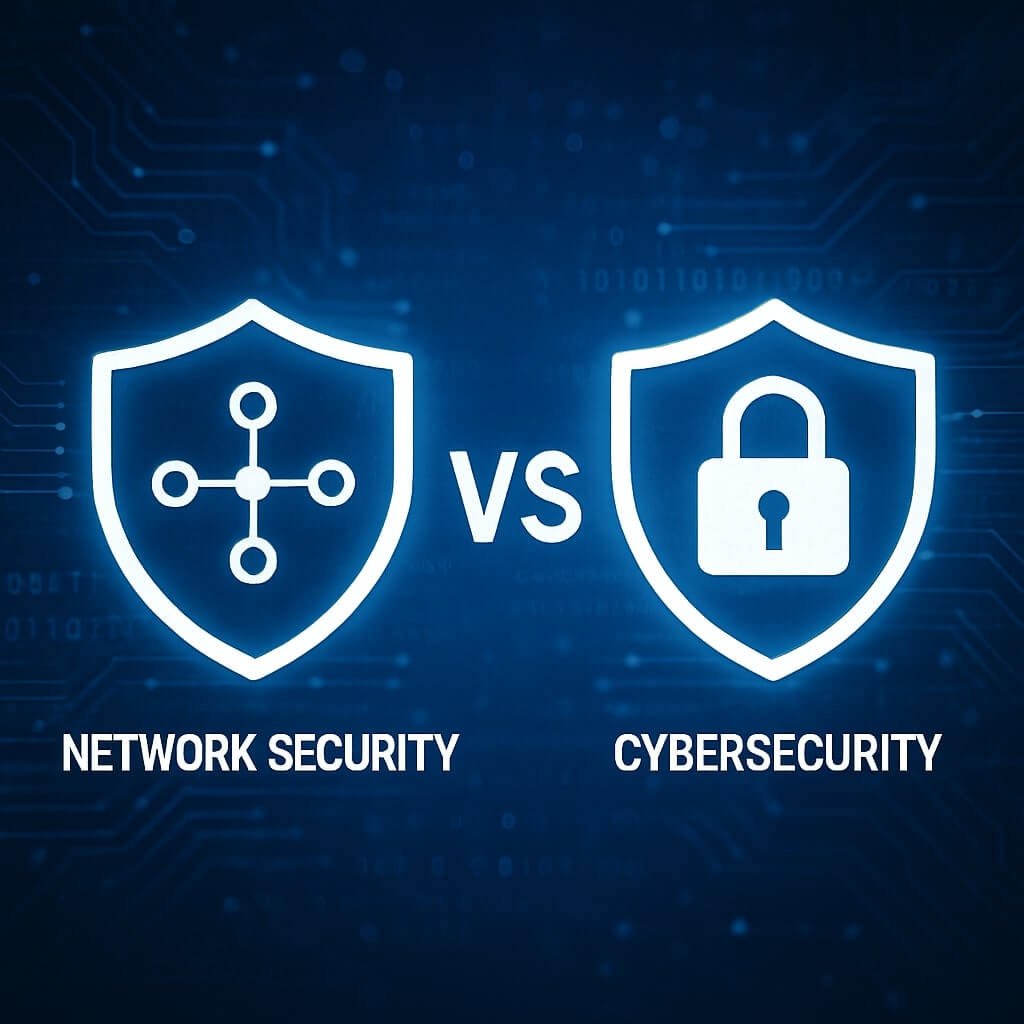When examining the distinction between network security and cybersecurity, it’s essential to recognize their differing scopes and focuses. Network security zeroes in on protecting computer networks from specific threats, while cybersecurity takes a broader approach to safeguard all digital assets. Understanding these differences not only clarifies their roles but also highlights the importance of integrating both for robust protection. What specific threats do each target, and how do their tools and strategies differ?
Key Takeaways
- Network security specifically protects computer networks, while cybersecurity encompasses a broader range of digital threats and protections across all platforms.
- Network security focuses on hardware and software technologies to secure communication channels, whereas cybersecurity addresses threats like phishing and ransomware.
- Risk assessments in network security often involve firewalls, while cybersecurity includes endpoint protection and data safeguarding strategies.
- Incident response for network security typically requires infrastructure adjustments, while cybersecurity responses involve data analysis and broader incident management.
- Understanding these distinctions aids in effectively allocating resources and tailoring security strategies for organizations.
Defining Network Security
Network security encompasses the strategies and measures designed to protect the integrity, confidentiality, and availability of your network and data.
It involves implementing robust network protocols that govern data transmission and communication between devices. You’ll need to guarantee that these protocols are configured correctly to prevent unauthorized access and mitigate vulnerabilities.
Access control mechanisms, such as firewalls and intrusion detection systems, play a vital role in managing who can access your network and what resources they can utilize.
Defining Cybersecurity
Cybersecurity encompasses a range of practices aimed at protecting systems, networks, and data from digital threats.
Understanding key concepts like threat vectors, vulnerabilities, and incident response is vital for evaluating its importance in today’s interconnected world.
As you explore these elements, you’ll see how they collectively safeguard not just information, but also the integrity of organizational operations.
Key Concepts Explained
In the domain of digital protection, defining cybersecurity involves understanding its foundational elements and objectives. At its core, cybersecurity focuses on safeguarding data integrity, confidentiality, and availability amidst a complex threat landscape.
You need to recognize that threats can come from various vectors, including malware, phishing, and insider threats, each necessitating specific countermeasures. Effective cybersecurity strategies encompass not only technical defenses but also policies and procedures that promote data protection across the organization.
This includes regular risk assessments, user training, and incident response plans to mitigate potential breaches. By thoroughly understanding these key concepts, you position yourself to better navigate the evolving challenges of cybersecurity and guarantee robust defenses against emerging threats.
Importance of Cybersecurity
Understanding the significance of cybersecurity goes beyond mere definitions; it’s about recognizing the real-world implications of data breaches and cyber threats.
You need to appreciate how these threats can compromise sensitive information, disrupt operations, and damage reputations. Cybersecurity awareness is essential for everyone, as it empowers you to identify potential risks and foster a culture of vigilance.
Implementing robust data protection strategies guarantees that your organization can defend against unauthorized access and data loss. This involves not only technical measures but also employee training and adherence to best practices.
Key Differences Between Network Security and Cybersecurity
While both network security and cybersecurity aim to protect digital assets, they focus on different aspects of security. Network security primarily safeguards the infrastructure, such as routers and switches, ensuring that unauthorized access is prevented.
In contrast, cybersecurity encompasses a broader scope, addressing threats to data across various platforms and applications. When you conduct a risk assessment, network security measures often involve firewalls and intrusion detection systems, while cybersecurity strategies may include endpoint protection and threat intelligence.
Additionally, incident response procedures differ; network security incidents often require immediate infrastructure adjustments, whereas cybersecurity incidents may necessitate a thorough analysis of compromised data and potential breaches.
Understanding these distinctions helps you effectively allocate resources and tailor your security strategy.
Common Threats Addressed by Network Security
Network security faces a variety of threats that can compromise the integrity and availability of your infrastructure.
To effectively protect your network, it’s essential to understand these common threats:
Understanding common network threats is crucial for effective protection against potential vulnerabilities.
- Malware Attacks: Malicious software can infiltrate your systems, leading to data breaches and system failures.
- Phishing Schemes: These deceptive tactics trick users into revealing sensitive information, often targeting credentials.
- Denial-of-Service (DoS) Attacks: Attackers overwhelm your network resources, rendering your services unavailable.
- Unauthorized Access: Intruders exploit vulnerabilities to gain control over your network, risking sensitive data exposure.
Common Threats Addressed by Cybersecurity
Cybersecurity tackles a range of threats that can jeopardize your organization’s sensitive data and overall digital environment. Among the most prevalent are malware attacks and phishing scams.
Malware attacks involve malicious software designed to disrupt, damage, or gain unauthorized access to your systems. These can manifest as viruses, ransomware, or spyware, each targeting different vulnerabilities within your network.
On the other hand, phishing scams exploit human psychology, tricking individuals into revealing confidential information, such as login credentials or financial data, often through deceptive emails or websites.
Tools and Technologies in Network Security
Effective network security relies on a variety of tools and technologies that work together to protect your organization’s data and infrastructure.
Effective network security combines various tools and technologies to safeguard your organization’s critical data and infrastructure.
To achieve robust security, consider implementing the following:
- Firewalls: Proper firewall configurations filter incoming and outgoing traffic, blocking unauthorized access.
- Intrusion Detection Systems (IDS): These systems monitor network traffic for suspicious activity and alert you to potential threats.
- Virtual Private Networks (VPNs): VPNs encrypt data transmitted over the network, ensuring secure remote access.
- Network Access Control (NAC): NAC solutions enforce policies on devices attempting to connect, ensuring only authorized users gain access.
Integrating these tools and technologies creates a thorough approach to safeguarding your network against evolving threats.
Tools and Technologies in Cybersecurity
While many tools overlap between network security and cybersecurity, the latter requires a distinct set of technologies designed to address a wider array of threats.
Key tools in cybersecurity include advanced encryption methods, which protect sensitive data by converting it into unreadable formats, ensuring confidentiality during transmission.
In addition, threat detection systems, such as intrusion detection and prevention systems (IDPS), play a vital role in identifying and mitigating potential attacks before they escalate. These systems utilize machine learning algorithms to analyze patterns and anomalies, enhancing your organization’s response capability.
Moreover, endpoint protection platforms (EPP) safeguard devices by continuously monitoring for vulnerabilities and malicious activities.
Together, these tools form a robust cybersecurity framework that actively defends against evolving threats.
Integrating Network Security and Cybersecurity for Comprehensive Protection
To achieve thorough protection against today’s multifaceted threats, integrating network security and cybersecurity is essential. This synergy enhances your organization’s resilience and guarantees extensive safety.
Here are four key elements to take into account:
- Security Frameworks: Adopt established frameworks like NIST or ISO to create a structured approach for both network and cybersecurity.
- Risk Assessment: Regularly evaluate vulnerabilities in both domains to identify potential threats and mitigate risks effectively.
- Incident Response: Develop a unified incident response strategy that addresses breaches across network and cybersecurity layers.
- Security Policies: Establish clear security policies that govern both network and cybersecurity practices, ensuring consistency and compliance.
Conclusion
To conclude, while network security and cybersecurity share the common goal of protecting digital assets, their focuses differ greatly. Network security zeroes in on safeguarding network infrastructure, while cybersecurity encompasses a wider array of digital threats and strategies. Understanding these distinctions is essential for implementing effective security measures. By integrating both approaches, you can achieve thorough protection, ensuring that your networks and sensitive data remain secure against evolving threats in the digital landscape.






